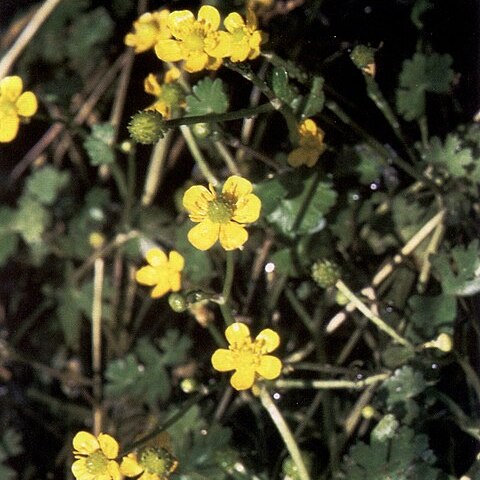Much like no. 21 [Ranunculus flabellaris Raf.]; segments of the submersed lvs mostly 2–4 mm wide; emersed lvs pentagonal, the principal segments again lobed and crenately toothed; sep 4–6 mm; pet mostly 4–8 mm; achenes nearly or quite smooth on the sides, the margins rounded but not tumid or conspicuously corky; beak 0.4–0.7 mm; 2n=16, 32. Shallow water and muddy shores, seldom wholly emersed; boreal Amer. and Asia, s. to Me., Mich., Io., N.D., and Colo. July, Aug. Our plants as here described are mostly glabrous or nearly so and represent the var. hookeri (D. Don) L. Benson, widespread in Amer. The var. gmelinii, tending to be hirsute, and with smaller fls (sep 2.5–3 mm, pet 3.5–4 mm) occurs chiefly in Alas. and nw. Can., but extends to n. Minn.
Stems prostrate or sometimes floating, glabrous or hirsute, rooting nodally. Leaves: basal leaves absent, cauline leaf blades reniform to circular, 3-parted, 0.6-6.5 × 1.1-9 cm, base cordate, segments again 1-3×-lobed to-dissected, margins entire or crenate, apex rounded to filiform. Flowers: receptacle sparsely hispid; sepals 4-5, spreading or reflexed from base, 2-5 × 2-4 mm, glabrous or sparsely pilose; petals 4-14, 3-7 × 2-5 mm; nectary scale variable, crescent-shaped, funnel-shaped, or flaplike; style 0.2-0.4 mm. Heads of achenes globose or ovoid, 3-8 × 3-7 mm; achenes 1-1.6 × 1-1.2 mm, glabrous; beak narrowly lanceolate or filiform, 0.4-0.8 mm. 2 n = 16, 32, 64.


